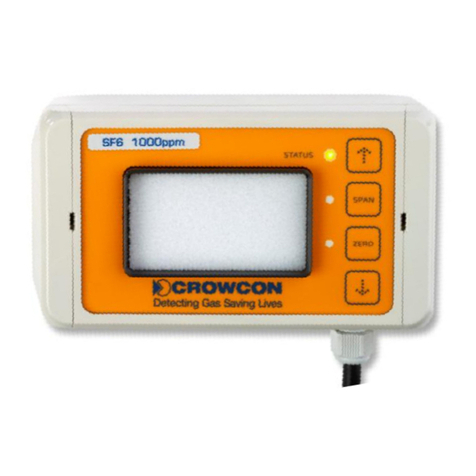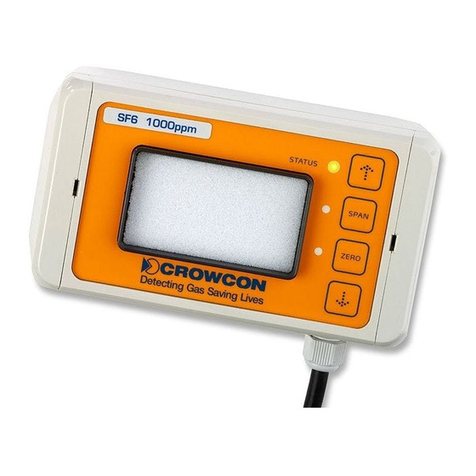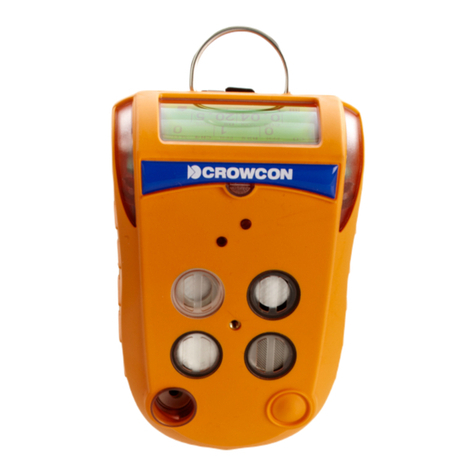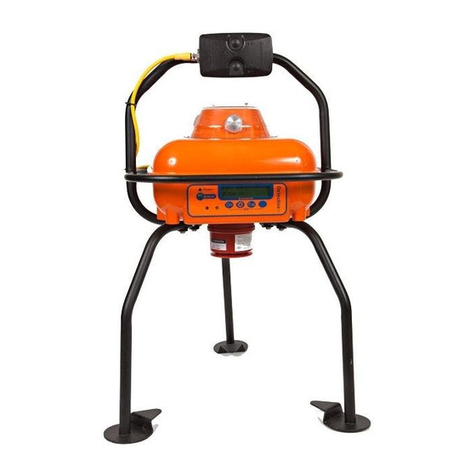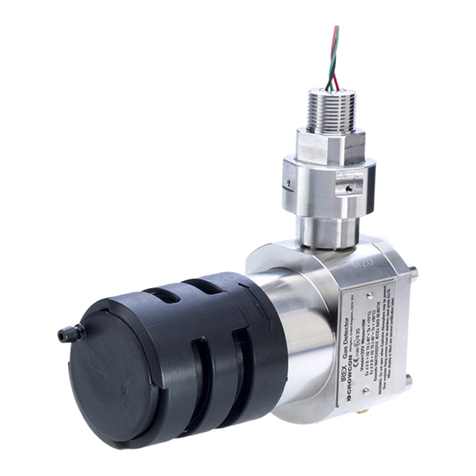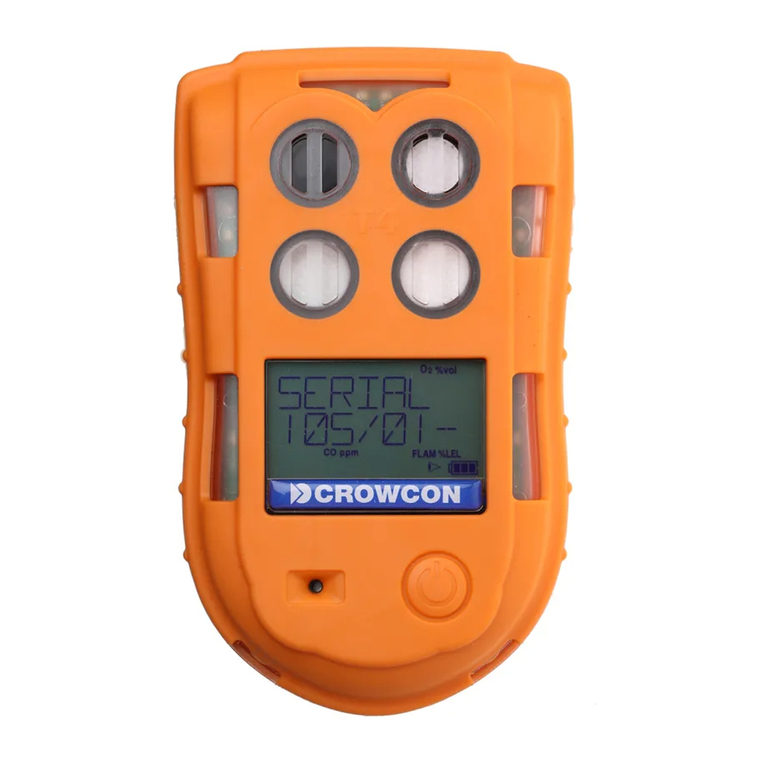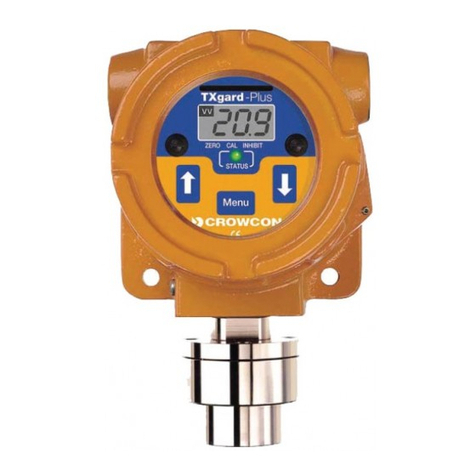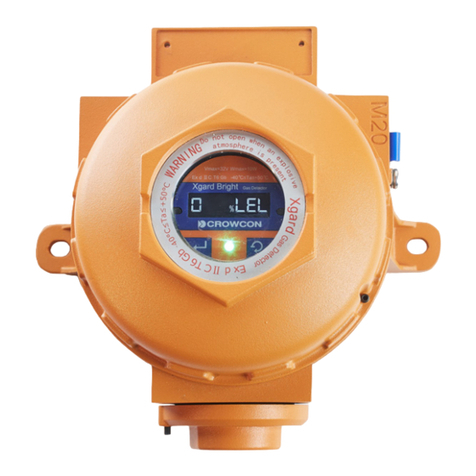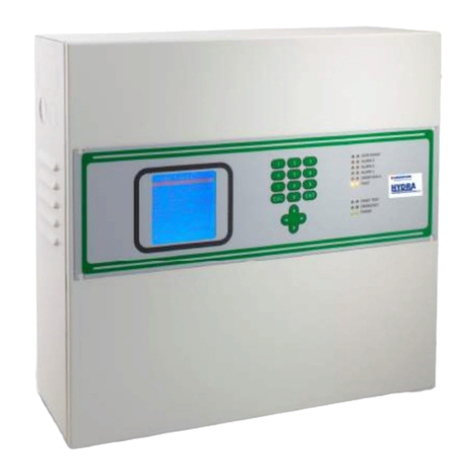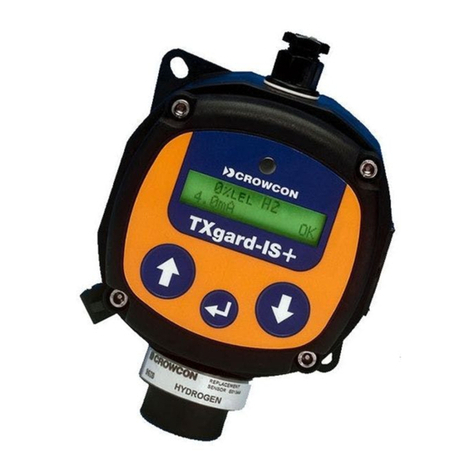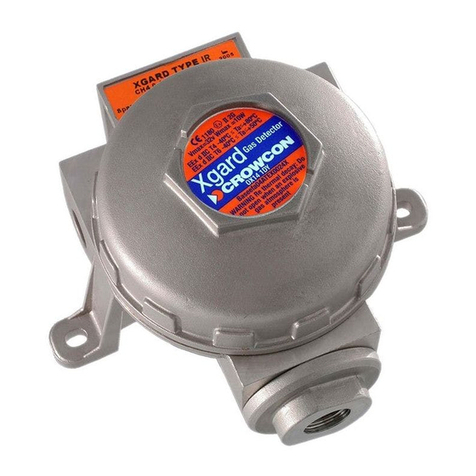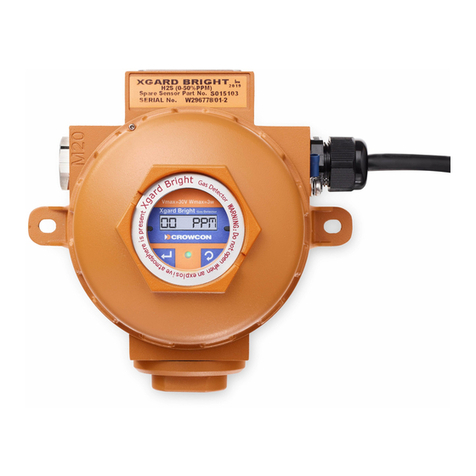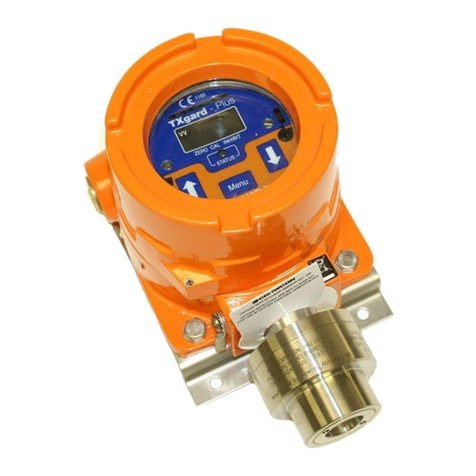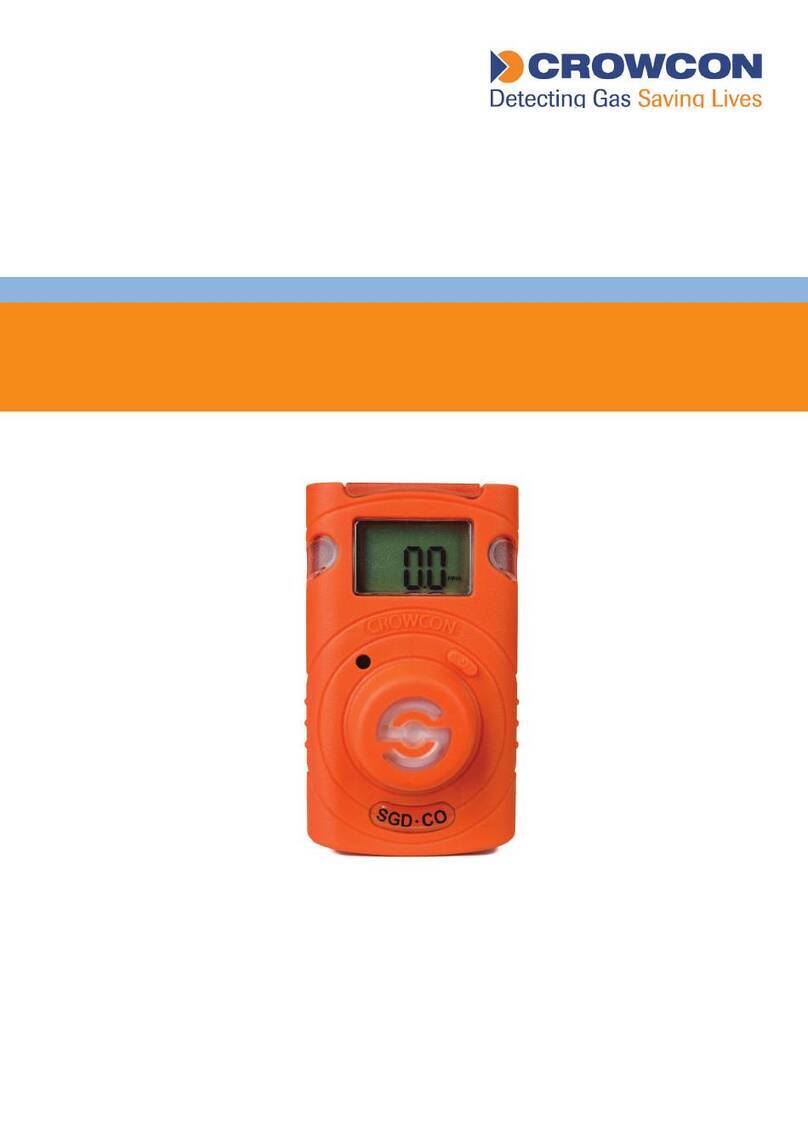
3. OPERATION2. INSTALLATION (continued)
NOTES
WARNING
Prior to carrying out any work ensure local regulations and site
procedures are followed.
Never attempt to open the detector or junction box when
flammable gas is present.
Ensure that the associated control panel is inhibited so as to
prevent false alarms.
3.1 Commissioning procedure
The following procedure should be followed carefully, and carried out
only by suitably trained personnel:
a. Open the junction box of the detector by removing the 4 M6 Allen
head screws.
b. Check that all electrical connections have been made and are
correct as per Diagram 3.
c. Apply power to the detector and ensure the minimum supply voltage
of 10 V dc is available at the detector across terminal ‘+’ and ‘-’.
d. Leave the detector to stabilise for 1 -2 hours.
e. Connect a digital volt meter (DVM) to the test points on the amplifier
in the junction box. Note : The test points read 40 mV = 4 mA = 0%
up to 200 mV = 20 mA = 100% LEL gas. There is a current clamp of
25 mA on the 4-20 mA output.
f. With no flammable gas present at the detector adjust the ‘ZERO’ pot
on the amplifier until the DVM reads 40 mV.
g. Apply calibration gas to the detector at a flow rate of 0.5 litres per
minute. Crowcon recommend 50% LEL gas for calibration purposes
(contact Crowcon for the supply of calibration gas).
h. Allow the gas reading to stabilise and adjust the ‘CAL’ pot until the
DVM reads the appropriate reading (120 mV = 50% LEL if used).
i. If the control equipment display requires adjustment consult the
operating manual for the equipment.
a. Switch off and isolate power to the detector requiring attention.
b. Open the junction box by unscrewing the 4 M6 Allen head screws.
c. Disconnect the 3 sensor wires from the terminal block of the
amplifier.
d. Unscrew the complete 96HD sensor housing from the junction box.
e. Open the 96HD sensor housing by removing the four Allen head
screws from the Top Cap with a 3mm Allen Key.
f. Remove the sensor from the Top Cap PCB. Flammable sensors have
an extra black sleeve which may be seperate from the sensor. This
is normal and the sleeve may be re-used.
g. Fit the replacement sensor checking the part number is correct. This
part number is labelled on the main body of the detector. Observe
pin alignment with PCB.
h. Inspect the gaskets and replace if necessary.
i. The sinter assembly will only need to be replaced if it has become
blocked by dust or oil. Such blockages cause the response time of
the detector to be slow and may affect sensitivity. To remove the
sinter a removal tool (Part No. M01614) is required. Loctite No 243
must be used on sinter assembly threads to maintain certification.
j. Re-assemble the 96HD housing taking time to ensure that the four
Allen head screws are securely fixed into position.
k. Fit the 96HD sensor housing to the junction box ensuring that the
colour coded wires are terminated correctly.
l. Remove the amplifier fixing screws and rear lid.
m. Connect a DVM to TP2 on the amplifier PCB.
n. Switch on power and adjust VR3 until DVM reads 0 mV.
o. Re-assemble the amplifier.
p. Follow the Commissioning Procedure given in 3.1 above.
If a spare 96HD sensor housing complete with new sensor is
available, ignore steps (e.) to (j.) and return the old 96HD to Crowcon or
an approved service centre for repair.
j. Close the junction box of the detector ensuring the 4 x M6 Allen head
screws are securely fastened.
k. The detector is now operational.
3.2 Routine maintenance
The operational life of the pellistor sensor depends on the application.
Crowcon expect that such a device will work satisfactorily for up to 5
years in ideal conditions. Site practices will dictate the frequency with
which detectors are tested. Crowcon recommends that detectors be gas
tested at least every 6 months and re-calibrated as necessary. To re-
calibrate a detector follow steps 3.1 (a.), (e.) to (k.) above.
Pellistors can suffer from loss of sensitivity when there is a
presence of poisons or inhibitors such as silicones, sulphides, chlorine,
lead or halogenated hydrocarbons. Crowcon use poison resistant
pellistors to maximise the operational life of Flamgard-4/20. In
applications where such compounds are present continuously we
recommend the use of CIRRUS or NIMBUS, Crowcon’s fixed point
infrared flammable gas detectors, which are immune to such poisons
and inhibitors. Please contact Crowcon for further details.
3.3 Sensor replacement/servicing of detectors
WARNING
This work should be carried out by Crowcon or an approved
service centre unless suitable training has been received.
Flamgard 4/20 uses the 96HD sensor housing which allows the user to
replace the sensors, gaskets and sinter if necessary. An exploded view
of the 96HD sensor housing is given in Diagram 2 for reference. The
following procedure may be followed when servicing the detector:
Area Classifications:-
Zone 0: An area classified, as Zone 0 will have ignitable
concentrations of flammable gases, vapours or
liquids present continuously or for long periods of
time under normal operating conditions.
Zone 1: An area classified, as Zone 1 is likely to have
ignitable concentrations of flammable gases,
vapours or liquids present under normal operating
conditions.
Zone 2: An area classified, as Zone 2 is not likely to have
ignitable concentrations of flammable gases,
vapours or liquids present under normal operating
conditions.
Dimensions 190 x 129 x 85 mm (7.3 x 5 x 3.4 inches)
Weight 4.0 kg (8.8 lbs)
Operating voltage 10-30 V dc
Current consumption 140 mA @ 10 V, 50mA @24V
Operating temperature -10-55OC
Humidity 0-99% RH, non condensing
Cable loop resistance 60 Ohm @ 22 V +ve terminal (power)
600 Ohm @ 22 V signal terminal (4-20 mA)
Degree of protection IP66 (when fitted with Weatherproof Cap)
Explosive protection Flameproof
Approval code II 2 G EEx d IIC T6
Safety certification no. Amplifier unit (Junction Box):
Baseefa03ATEX0074
96HD: Sira02ATEX1283X
Standards EN50014, EN50018
Zones Certified for use in Zone 1 or Zone 2 areas.
(see area classifications section)
Gas groups IIA, IIB, IIC
EMC EN50270
Detector output Source or sink selected by internal switch
Description Part Number
M20 to 1/2” NPTF adaptor M02125
M20 to 3/4” NPTF adaptor M02281
Ceiling mounting bracket M01401
Collector cone C01051
Spray deflector C01338
Swivel mounting bracket C01340
96HD sensor housing complete with sensor S01749*1
Replacement sensor S01673*1
Sinter removal tool M01 614
Loctite No. 243
Sinter assembly S01781
Gasket 1 M04452
Gasket 2 M04128
Calibration gas Contact Crowcon
*1 Flamgard 4/20 may be fitted with a range of pellistor sensors depending on the
specific application. The correct spare sensor part number is itemised on the
sensor housing label.
4. SPARE PARTS AND ACCESSORIES 5. SPECIFICATION
7 8 9 10
11 12
Diagram 3: Electrical connections
